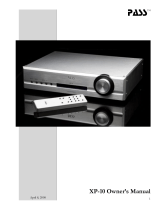Manley MIC EQ 500 Combo Owner's manual
- Category
- Musical Equipment
- Type
- Owner's manual
This manual is also suitable for
Manley MIC EQ 500 Combo is a high-quality microphone preamplifier and equalizer that offers a wide range of features and capabilities. With its fully differential tube amplifier, transformer input and output, and passive EQ section, the MIC EQ 500 Combo is designed to provide pristine sound quality and maximum flexibility.
The MIC EQ 500 Combo is ideal for a variety of applications, including recording, mixing, and mastering. It can be used to add warmth and character to vocals, instruments, and other audio sources. The EQ section provides precise control over the sound, with boost and cut capabilities at various frequencies.
Manley MIC EQ 500 Combo is a high-quality microphone preamplifier and equalizer that offers a wide range of features and capabilities. With its fully differential tube amplifier, transformer input and output, and passive EQ section, the MIC EQ 500 Combo is designed to provide pristine sound quality and maximum flexibility.
The MIC EQ 500 Combo is ideal for a variety of applications, including recording, mixing, and mastering. It can be used to add warmth and character to vocals, instruments, and other audio sources. The EQ section provides precise control over the sound, with boost and cut capabilities at various frequencies.
















-
 1
1
-
 2
2
-
 3
3
-
 4
4
-
 5
5
-
 6
6
-
 7
7
-
 8
8
-
 9
9
-
 10
10
-
 11
11
-
 12
12
-
 13
13
-
 14
14
-
 15
15
-
 16
16
Manley MIC EQ 500 Combo Owner's manual
- Category
- Musical Equipment
- Type
- Owner's manual
- This manual is also suitable for
Manley MIC EQ 500 Combo is a high-quality microphone preamplifier and equalizer that offers a wide range of features and capabilities. With its fully differential tube amplifier, transformer input and output, and passive EQ section, the MIC EQ 500 Combo is designed to provide pristine sound quality and maximum flexibility.
The MIC EQ 500 Combo is ideal for a variety of applications, including recording, mixing, and mastering. It can be used to add warmth and character to vocals, instruments, and other audio sources. The EQ section provides precise control over the sound, with boost and cut capabilities at various frequencies.
Ask a question and I''ll find the answer in the document
Finding information in a document is now easier with AI
Related papers
-
Manley Langevin Dual Vocal Combo Owner's manual
-
Manley CONTROL MASTER PREAMPLIFIER User manual
-
Manley Purist Preamplifier (1995-2001) Owner's manual
-
Manley 60dB Mic Pre 1990 - 1994 Owner's manual
-
Manley Langevin Dual Mic Pre Owner's manual
-
Manley Slam Owner's manual
-
Manley Dual Mono Mic Preamp Owner's manual
-
Manley 40dB Mic Pre Owner's manual
-
Manley 16 X 2 Tube Mixer User manual
-
Manley 20 BIT DIGITAL TO ANALOG CONVERTER User manual
Other documents
-
Peavey MA Series Module MPE-SO Owner's manual
-
 Schatten Design Mini Pre 2 Acoustic Preamp Owner's manual
Schatten Design Mini Pre 2 Acoustic Preamp Owner's manual
-
Universal Audio UAD Plug-Ins Owner's manual
-
Universal Audio UAD Plug-Ins Owner's manual
-
 Pass Labs XP-10 User manual
Pass Labs XP-10 User manual
-
Universal Audio Apollo x8 User manual
-
Nobsound High Precision Passive Preamp Volume Controller Operating instructions
-
 Pass Labs Stereo Amplifier X1 User manual
Pass Labs Stereo Amplifier X1 User manual
-
Universal Audio Apollo Twin MkII User manual
-
Millennia STT-1 Owner's manual


















